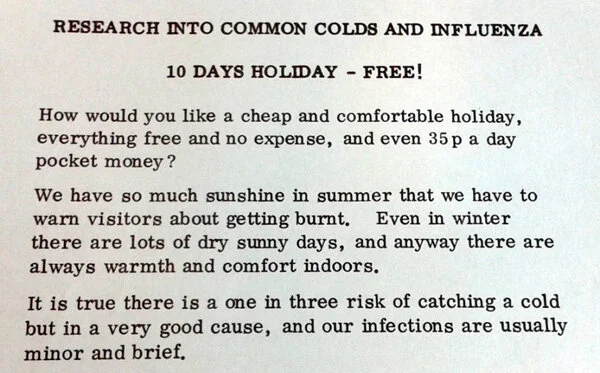Deliberate COVID-19 infection: The gamble with a long pedigree
The UK is set to host the world's first human challenge trial for COVID-19 – intentionally infecting healthy young volunteers to speed up the search for a vaccine.
A $13 million UK government contract was announced on Tuesday by hVIVO, a London-based research company, which is a subsidiary of Dublin-based pharmaceutical concern Open Orphan. The trial will start in January with a characterization study at London's Royal Free Hospital, attempting to establish the minimum dose of the SARS-CoV-2 virus needed to cause the COVID-19 infection.
This characterization study, which will be sponsored by Imperial College London, is subject to regulatory and ethical review – and there is debate in the medical world as to the nature of human challenge trials, also known as human infection studies. Although they help accelerate the process of finding vaccines, their method is to deliberately expose subjects to diseases for which there is no cure.
"No study is completely risk-free, but [we] will be working hard to ensure we make the risks as low as we possibly can," said Imperial College scientist Chris Chiu. A World Health Organization spokeswoman insisted any such trial "must be overseen by an ethics committee, the volunteers must have full consent and they must select the volunteers in order to minimize their risk."
Historical precedent
Challenge trials are now very carefully monitored, but they go back more than 200 years. In 1796, the English physician Edward Jenner took a calculated gamble that the feared killer disease smallpox could be avoided by someone who had previously had the much milder cowpox.
Jenner purposefully gave the eight-year-old son of his gardener cowpox, then – presumably with hope and trepidation – a dose of smallpox. The boy did not develop smallpox and humans were on their way to the first successful eradication of a deadly viral infection.
Human challenge trials have since been used to accelerate cures for cholera, typhoid fever, malaria, tuberculosis, influenza, whooping cough and dengue fever. Intriguingly, the UK also spent more than four decades using challenge trials in an attempt to conquer a perhaps less deadly but more everyday problem – the common cold.
From 1946 to 1989, the Common Cold Research Unit operated at Harvard Hospital, at Harnham Down near Salisbury in Wiltshire. As its name might suggest, Harvard Hospital had been set up by the U.S. university, in a war time effort to study the possible effects of epidemics. The Americans paid for, supplied, staffed and equipped a 600-bed hospital, the buildings being shipped across the Atlantic, and the whole operation gifted to the UK when World War II ended.
Focusing upon the common cold, from July 1946 the unit settled upon a routine of two-week trials attended by 30 volunteers who were paid a small amount as compensation. (Modern challenge-trial volunteers are typically paid around $5,000, but this amount is changeable subject to oversight by ethics committees.)
Volunteers usually stayed for 10 days, 24 at a time housed in small isolated groups of two or three – the thinking being that 10 days of isolation would be undesirable. Each small group shared a lounge, kitchen and bathroom but had separate bedrooms for privacy. They were checked every day by staff in masks and gowns, and any newcomers showing preliminary signs of an existing cold were sent away.
Relax and research
Although forbidden from entering any residential areas, volunteers were welcome to go out for walks amid the vast solitude of Salisbury Plain. Indeed, during a time when most work was in heavy industry or office work in towns and cities and foreign travel was restricted to very few people, a stay at the research unit was advertised in newspapers and magazines marketed as an unusual holiday opportunity in an attractive part of the countryside, at no cost and with financial reimbursement.
After leaving the unit, volunteers were encouraged to spread the word among friends and told they could reapply, every six months. Indeed, one couple recorded a total of 21 visits. With all accommodation linked by free telephones, visitors were free to chat by phone – as long as they maintained physical distance for the 10 days.
Several relationships bloomed, including one between a male guitarist and female oboist who dueted outside their neighboring accommodation units. It was not unknown for honeymooners to arrive back at the scene of their meeting. If Gabriel Garcia Marquez were to write about it, he might call it Love in the Time of the Common Cold.
While the volunteers relaxed, the researchers worked diligently and expanded the scientific knowledge base: in 1965, the unit successfully introduced a coronavirus-based cold into volunteers. It is now known that up to 15 percent of common colds are caused by coronaviruses, a percentage outweighed only by rhinoviruses.
After hosting more than 20,000 volunteers, the Common Cold Research Unit closed down in 1990 but scientific research goes on, as it must. While the idea of purposeful infection may seem like an illogical thing to do, it is a centuries-old idea that has reaped significant rewards.
The common cold remains undefeated – with more than 200 virus strains giving the average adult two to three colds per year and the average child six to eight, it seems to be just too variable to vaccinate against.
The hope is that the latest challenge trial will help accelerate a cure for the new coronavirus which has been threatening lives and livelihoods around the world.





